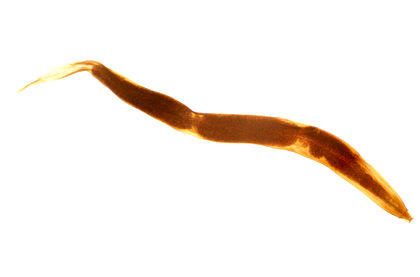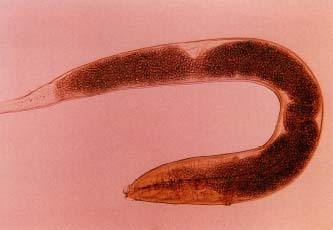Pinworm (Enterobiasis)

Pinworm, or enterobiasis (en-ter-o-BY-a-sis), is a common intestinal infection caused by the Enterobius vermicularis parasite. It causes anal itching, and it is often spread by children to schoolmates or family members.
KEYWORDS
for searching the Internet or other reference sources
Gastrointestinal system
Infestation
Nematodes
* contagious means transmitable from one person to another.
Pinworm, or Enterobius vermicularis (en-ter-O-be-us ver-mik-u-LAY-ris), is a common and highly contagious * intestinal parasite. An estimated

What Is the Pinworm's Life Cycle?
People become infected when they unknowingly swallow microscopic pin-worm eggs. The pinworm eggs pass through the digestive tract, where they hatch in the small intestine into a larval * stage. Pinworm larvae then travel from the small intestine to the large intestine, where they attach to the intestinal wall. About two to six weeks after the eggs have been swallowed, adult female pinworms migrate from the large intestine to the rectum, where they exit from the anus to lay numerous eggs on nearby skin. The adult pinworms then return to the large intestine, where they usually die, but the new eggs become active within a few hours and remain active for up to three weeks.
Egg laying can cause itching in the infected person's anal area, and pin-worm eggs can be transferred from fingers to clothing, bedding, towels, toilets, and other objects in the environment. When people handle objects that have become contaminated with pinworm eggs, they may inadvertently touch their fingers to their lips afterward and swallow the new eggs, allowing the pinworm life cycle to begin again.
* larva is an intermediate stage in a worm's life cycle between egg and adult.
What Are the Signs and Symptoms of Pinworm Infection?
The most common symptom is anal itching, but most people with pin-worms show no symptoms at all. Because female pinworms usually lay their eggs at night, this is when itching can be most intense, and it may interfere with sleep or may cause restless sleep. Sometimes, anal itching is so minor that it is not recognized as a symptom. In females, pinworms can migrate to the vagina, causing itching and vaginal discharge.
How Do Doctors Diagnose and Treat Pinworm Infection?
Diagnosis
Pinworm infections are diagnosed if doctors find adult female worms or eggs around the anus. Doctors (or parents) place adhesive tape on the skin in the anal area, usually in the morning as egg laying occurs overnight. When the tape is removed and viewed under a microscope, eggs or worms stuck to the tape are visible.
Treatment
When infection is confirmed, treatment is started. A single dose of prescription medication is given, sometimes with a follow-up dose two weeks later. Because of the contagious nature of pinworm infection, usually everyone in the household is treated. Reinfection is common and treatment may have to be repeated.
How Do People Prevent Pinworm Infection?
Proper personal hygiene can help prevent pinworm infections. It is important to wash hands after going to the bathroom and before eating. Bathing and changing underwear regularly are also useful. Despite such precautions, however, reinfection is common, particularly in children.
See also
Ascariasis
Trichinosis
Worms
Resource
The U.S. National Institute of Allergy and Infectious Diseases posts a
fact sheet about pinworm and other parasitic roundworm diseases at its
website.
http://www.niaid.nih.gov/factsheets/roundwor.htm
Comment about this article, ask questions, or add new information about this topic: